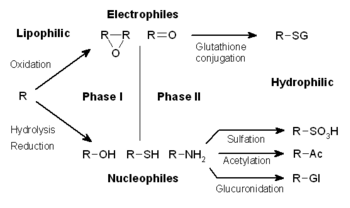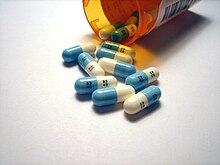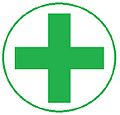Types of pharmacy practice areas
Pharmacists practice in a variety of areas including retail, hospitals, clinics, nursing homes, mental hospitals, and regulatory agencies. Pharmacists can specialize in various areas of practice including but not limited to: hematology/oncology, infectious diseases, ambulatory care, nutrition support, drug information, critical care, pediatrics, etc.

19th century Italian pharmacy

Modern pharmacy in Norway
A
pharmacy (commonly the
chemist in
Australia,
New Zealand and the
UK; or
drugstore in
North America;
retail pharmacy in industry terminology; or
Apothecary, historically) is the place where most pharmacists practice the profession of pharmacy. It is the community pharmacy where the dichotomy of the profession exists—health professionals who are also retailers.
Community pharmacies usually consist of a retail storefront with a dispensary where medications are stored and dispensed. The opening of the first drugstores are recorded by
Muslim pharmacists in
Baghdad in 754.
[5][6]In most countries, the dispensary is subject to pharmacy legislation; with requirements for storage conditions, compulsory texts, equipment, etc., specified in legislation. Where it was once the case that pharmacists stayed within the dispensary compounding/dispensing medications, there has been an increasing trend towards the use of trained
pharmacy technicians while the pharmacist spends more time communicating with patients. Pharmacy technicians are now more dependent upon automation to assist them in their new role dealing with patients' prescriptions and patient safety issues.
Pharmacies are typically required to have a pharmacist on-duty at all times when open. It is also often a requirement that the owner of a pharmacy must be a registered pharmacist, although this is not the case in all jurisdictions, such that many
retailers (including
supermarkets and
mass merchandisers) now include a pharmacy as a department of their store.
[edit]Hospital pharmacy
Pharmacies within
hospitals differ considerably from community pharmacies. Some pharmacists in hospital pharmacies may have more complex clinical medication management issues whereas pharmacists in community pharmacies often have more complex business and customer relations issues.
Because of the complexity of medications including specific indications, effectiveness of treatment regimens, safety of medications (i.e., drug interactions) and
patient compliance issues (in the hospital and at home) many pharmacists practicing in hospitals gain more education and training after pharmacy school through a pharmacy practice residency and sometimes followed by another residency in a specific area. Those pharmacists are often referred to as clinical pharmacists and they often specialize in various disciplines of pharmacy. For example, there are pharmacists who specialize in hematology/oncology, HIV/AIDS, infectious disease, critical care,
emergency medicine, toxicology, nuclear pharmacy, pain management, psychiatry, anti-coagulation clinics,
herbal medicine, neurology/epilepsy management, pediatrics, neonatal pharmacists and more.
Hospital pharmacies can often be found within the premises of the hospital. Hospital pharmacies usually stock a larger range of medications, including more specialized medications, than would be feasible in the community setting. Most hospital medications are unit-dose, or a single dose of medicine. Hospital pharmacists and trained pharmacy technicians compound sterile products for patients including
total parenteral nutrition (TPN), and other medications given intravenously. This is a complex process that requires adequate training of personnel,
quality assurance of products, and adequate facilities. Several hospital pharmacies have decided to
outsource high risk preparations and some other compounding functions to companies who specialize in compounding. The high cost of medications and drug-related technology, combined with the potential impact of medications and pharmacy services on patient-care outcomes and patient safety, make it imperative that hospital pharmacies perform at the highest level possible.
[edit]Clinical pharmacy
Clinical pharmacists provide direct patient care services that optimizes the use of medication and promotes health, wellness, and disease prevention.
[7] Clinical pharmacists care for patients in all
health care settings but the clinical pharmacy movement initially began inside
hospitals and
clinics. Clinical pharmacists often collaborate with
physicians and other healthcare professionals to improve pharmaceutical care. Clinical pharmacists are now an integral part of the interdisciplinary approach to patient care. They work collaboratively with physicians, nurses and other healthcare personnel in various medical and surgical areas. They often participate in patient care rounds and drug product selection.
In most hospitals in the United States, potentially dangerous drugs that require close monitoring are dosed and managed by clinical pharmacists.
[citation needed][edit]Compounding pharmacy
Main article:
CompoundingCompounding is the practice of preparing drugs in new forms. For example, if a drug manufacturer only provides a drug as a tablet, a compounding pharmacist might make a medicated
lollipop that contains the drug. Patients who have difficulty swallowing the tablet may prefer to suck the medicated lollipop instead.
Another form of compounding is by mixing different strengths (g,mg,mcg) of capsules or tablets to yield the desired amount of medication indicated by the doctor. This form of compounding is found at community or hospital pharmacies or in-home administration therapy.
Compounding pharmacies specialize in compounding, although many also dispense the same non-compounded drugs that patients can obtain from community pharmacies.
[edit]Consultant pharmacy
Consultant pharmacy practice focuses more on medication regimen review (i.e. "cognitive services") than on actual dispensing of drugs. Consultant pharmacists most typically work in
nursing homes, but are increasingly branching into other institutions and non-institutional settings.
[8] Traditionally consultant pharmacists were usually independent business owners, though in the United States many now work for several large pharmacy management companies (primarily
Omnicare,
Kindred Healthcare and
PharMerica). This trend may be gradually reversing as consultant pharmacists begin to work directly with patients, primarily because many elderly people are now taking numerous medications but continue to live outside of institutional settings. Some community pharmacies employ consultant pharmacists and/or provide consulting services.
[edit]Internet pharmacy
Since about the year 2000, a growing number of
internet pharmacies have been established worldwide. Many of these pharmacies are similar to community pharmacies, and in fact, many of them are actually operated by
brick-and-mortar community pharmacies that serve consumers online and those that walk in their door. The primary difference is the method by which the medications are requested and received. Some customers consider this to be more convenient and private method rather than traveling to a community drugstore where another customer might overhear about the drugs that they take. Internet pharmacies (also known as Online Pharmacies) are also recommended to some patients by their physicians if they are homebound.
While most internet pharmacies sell
prescription drugs and require a valid prescription, some internet pharmacies sell prescription drugs without requiring a prescription. Many customers order drugs from such pharmacies to avoid the "inconvenience" of visiting a doctor or to obtain medications which their doctors were unwilling to prescribe. However, this practice has been criticized as potentially dangerous, especially by those who feel that only doctors can reliably assess contraindications, risk/benefit ratios, and an individual's overall suitability for use of a medication. There also have been reports of such pharmacies dispensing substandard products.
[citation needed]Of particular concern with internet pharmacies is the ease with which people, youth in particular, can obtain
controlled substances (e.g.,
Vicodin, generically known as
hydrocodone) via the internet without a prescription issued by a doctor/practitioner who has an established doctor-patient relationship. There are many instances where a practitioner issues a prescription, brokered by an internet server, for a controlled substance to a "patient" s/he has never met.
[citation needed] In the United States, in order for a prescription for a controlled substance to be valid, it must be issued for a legitimate medical purpose by a licensed practitioner acting in the course of legitimate doctor-patient relationship. The filling pharmacy has a corresponding responsibility to ensure that the prescription is valid. Often, individual state laws outline what defines a valid patient-doctor relationship.
Canada is home to dozens of licensed internet pharmacies, many of which sell their lower-cost prescription drugs to U.S. consumers, who pay one of the world's highest drug prices.
[citation needed] In recent years, many consumers in the US and in other countries with high drug costs, have turned to licensed internet pharmacies in India, Israel and the UK, which often have even lower prices than in Canada.
In the
United States, there has been a push to legalize importation of medications from
Canada and other countries, in order to reduce consumer costs. While in most cases importation of prescription medications violates
Food and Drug Administration (FDA) regulations and federal laws, enforcement is generally targeted at international drug suppliers, rather than consumers. There is no known case of any U.S. citizens buying Canadian drugs for personal use with a prescription, who has ever been charged by authorities.
Recently developed online services like Australia's
Medicine Name Finder and the Walgreens'
Drug Info Search provide information about pharmaceutical products but do not offer prescriptions or drug dispensations. These services often promote
generic drug alternatives by offering comparative information on price and effectiveness.
[edit]Veterinary pharmacy
Veterinary pharmacies, sometimes called
animal pharmacies, may fall in the category of hospital pharmacy, retail pharmacy or mail-order pharmacy. Veterinary pharmacies stock different varieties and different strengths of medications to fulfill the pharmaceutical needs of animals. Because the needs of animals, as well as the regulations on
veterinary medicine, are often very different from those related to people, veterinary pharmacy is often kept separate from regular pharmacies.
[edit]Nuclear pharmacy
Nuclear pharmacy focuses on preparing radioactive materials for diagnostic tests and for treating certain diseases. Nuclear pharmacists undergo additional training specific to handling radioactive materials, and unlike in community and hospital pharmacies, nuclear pharmacists typically do not interact directly with patients.
[edit]Military pharmacy
Military pharmacy is an entirely different working environment due to the fact that technicians perform most duties that in a civilian sector would be illegal. State laws of Technician patient counseling and medication checking by a pharmacist do not apply.
[citation needed][edit]Pharmacy informatics
Pharmacy informatics is the combination of pharmacy practice science and applied information science. Pharmacy informaticists work in many practice areas of pharmacy, however, they may also work in information technology departments or for
healthcare information technology vendor companies. As a practice area and specialist domain, pharmacy informatics is growing quickly to meet the needs of major national and international patient information projects and health system interoperability goals. Pharmacists in this area are trained to participate in medication management system development, deployment and optimization.
[edit]Issues in pharmacy
[edit]Separation of prescribing from dispensing
In most jurisdictions (such as the
United States),
pharmacists are regulated separately from
physicians. These jurisdictions also usually specify that
only pharmacists may supply scheduled
pharmaceuticals to the public, and that pharmacists cannot form business
partnershipswith physicians or give them "kickback" payments. However, the
American Medical Association (AMA) Code of Ethics provides that physicians may dispense drugs within their office practices as long as there is no patient exploitation and patients have the right to a written prescription that can be filled elsewhere. 7 to 10 percent of American physicians practices reportedly dispense drugs on their own.
[11]In some rural areas in the United Kingdom, there are dispensing doctors
[12] who are allowed to both prescribe and dispense prescription-only medicines to their patients from within their practices. The law requires that the GP practice be located in a designated rural area and that there is also a specified, minimum distance (currently 1.6 kilometres) between a patient's home and the nearest retail pharmacy.
In Canada it is common for a medical clinic and a pharmacy to be located together and for the ownership in both enterprises to be common, but licensed separately.
The reason for the majority rule is the high risk of a conflict of interest and/or the avoidance of absolute powers. Otherwise, the physician has a financial self-interest in "diagnosing" as many conditions as possible, and in exaggerating their seriousness, because he or she can then sell more medications to the patient. Such self-interest directly conflicts with the patient's interest in obtaining cost-effective medication and avoiding the unnecessary use of medication that may have
side-effects. This system reflects much similarity to the checks and balances system of the U.S. and many other governments.
[citation needed]A campaign for separation has begun in many countries and has already been successful (like in
Korea). As many of the remaining nations move towards separation, resistance and lobbying from dispensing doctors who have pecuniary interests may prove a major stumbling block (e.g. in
Malaysia).
[citation needed][edit]The future of pharmacy
In the coming decades, pharmacists are expected to become more integral within the
health care system. Rather than simply dispensing medication, pharmacists are increasingly expected to be compensated for their patient care skills.
[13] In particular,
Medication Therapy Management (MTM) includes the clinical services that pharmacists can provide for their patients. Such services include the thorough analysis of all medication (
prescription, non-prescription, and herbals) currently being taken by an individual. The result is a reconciliation of medication and patient education resulting in increased patient health outcomes and decreased costs to the health care system.
[14]This shift has already commenced in some countries; for instance, pharmacists in
Australia receive remuneration from the
Australian Government for conducting comprehensive Home Medicines Reviews. In Canada, pharmacists in certain provinces have limited prescribing rights (as in Alberta and British Columbia) or are remunerated by their provincial government for expanded services such as medications reviews (Medschecks in Ontario). In the United Kingdom, pharmacists who undertake additional training are obtaining prescribing rights. They are also being paid for by the government for
medicine use reviews. In Scotland the pharmacist can write prescriptions for Scottish registered patients of their regular medications, for the majority of drugs, except for controlled drugs, when the patient is unable to see their doctor, as could happen if they are away from home or the doctor is unavailable. In the United States, pharmaceutical care or
clinical pharmacy has had an evolving influence on the practice of pharmacy.
[7] Moreover, the
Doctor of Pharmacy (Pharm. D.) degree is now required before entering practice and some pharmacists now complete one or two years of residency or fellowship training following graduation. In addition,
consultant pharmacists, who traditionally operated primarily in
nursing homes are now expanding into direct consultation with patients, under the banner of "senior care pharmacy."
[15][edit]Pharmacy Journals
[edit]See also
[edit]Symbols
The two
symbols most commonly associated with pharmacy are the
mortar and pestle and the
℞(
recipere) character, which is often written as "Rx" in typed text. The
show globe was also used in English-speaking countries until the early 20th century. Pharmacy organizations often use other symbols, such as the
Bowl of Hygieia which is often used in the
Netherlands,
conical measures, and
caduceuses in their
logos. Other symbols are common in different countries: the green
Greek cross in
France,
Argentina, the
United Kingdom,
Belgium,
Italy and
Spain, the increasingly rare
Gaper in the
Netherlands, and a red stylized letter A in
Germany and
Austria(from
Apotheke, the
German word for pharmacy, from the same
Greek root as the
English word 'apothecary').
The green Cross used in Greece, Spain, Italy, Argentina, France, Poland, the United Kingdom and other countries
The red stylized "A" (Apotheke) used in Germany
The Gaper used in the Netherlands
Identification Mark for Indian Pharmacist













